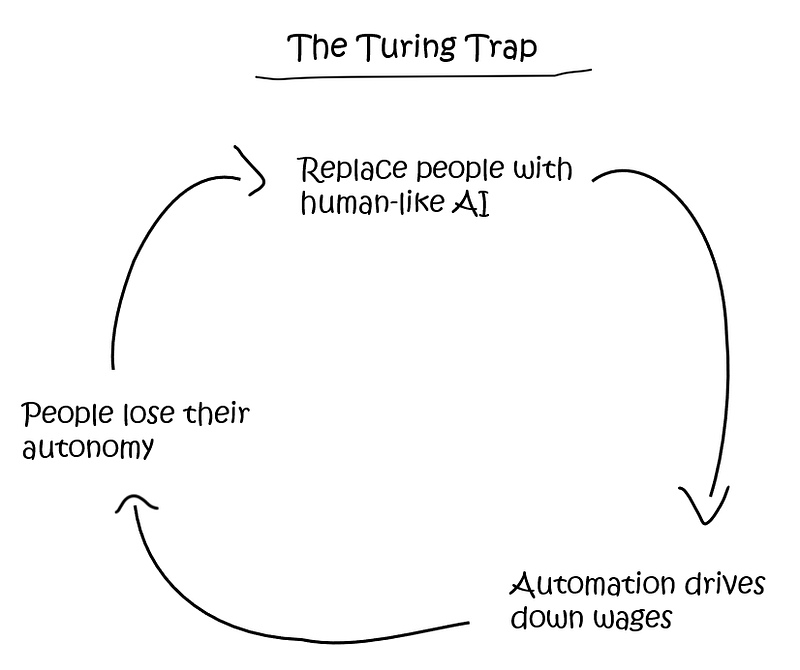Navigating the Turing Trap: Rethinking AI's Human-Like Pursuits
Written on
Chapter 1: The Allure of Human-Like AI
The fascination with developing AI that mimics human behavior is pervasive among technologists, entrepreneurs, policymakers, and business leaders. This obsession, termed the Turing Trap by Erik Brynjolfsson, a professor at the Stanford Institute for Human-Centered AI, can hinder genuine progress in the field of artificial intelligence. Brynjolfsson elaborated on the Turing Trap during his recent presentation at the New Horizons in Generative AI conference at Stanford.
The concept traces back to Alan Turing, a pivotal figure in computing history. Many may recognize him from school lessons about his role in breaking the German Enigma code during World War II or from the film "The Imitation Game." Turing proposed the imitation game, where a machine must convince a human judge that it is human through written communication. If the judge cannot distinguish between the two, the machine passes the Turing test.
Although constructing AI that mirrors human behavior is a compelling challenge, Brynjolfsson argues that it is not the ideal objective if we aim for AI to genuinely enhance human lives. He outlines ten theses that highlight the pitfalls associated with human-like AI and suggests more beneficial alternatives.
Section 1.1: Exploring the Ten Theses of the Turing Trap
Brynjolfsson's Ten Theses of the Turing Trap illuminate the complications that arise when AI is designed to replicate human behavior, as well as potential pathways to circumvent these challenges. Here’s a summary of the key points:
- The advantages of human-like AI are significant.
- Not all forms of AI emulate human attributes.
- The more closely a machine resembles a human, the greater its potential to replace human labor.
- Automation tends to decrease wages for human workers.
- Such substitution can diminish the economic and political influence of displaced workers.
- Reducing power and agency results in a cyclical disadvantage.
- Conversely, AI can enhance human labor and foster creativity.
- Augmentation and innovation can lead to wage increases.
- This approach generates not only new capabilities but also novel products and services.
- Current incentives disproportionately favor labor substitution over augmentation.
While the idea of having human-like AI handle our jobs might seem appealing, it’s vital to recognize that not all AI must mimic humanity. For instance, calculators excel at arithmetic tasks far beyond human capability. Similarly, other forms of intelligence exist, such as that of chimpanzees, which utilize superior short-term memory for tasks humans struggle with. Instead of striving for machines that imitate us, we could leverage AI to complement our unique strengths.
Brynjolfsson emphasizes that human-like AI excels primarily at replacing workers. Businesses often prefer machines, as they are efficient, tireless, and compliant. Therefore, employing humans makes financial sense only if their wages are lower than those of machines, which leads to wage suppression.
This cycle—where individuals lose their economic power and autonomy—illustrates the Turing Trap.

Section 1.2: The Benefits of AI Augmentation
As we become ensnared in the Turing Trap, we often overlook the positive potential of AI. Technology can enhance human capabilities and ignite creativity. For example, even basic calculators can boost productivity and problem-solving skills.
The augmentation process allows us to harness technological advancements for creative endeavors, pushing us toward greater achievements and improved quality of life. So why do we not aim to develop machines that augment human capabilities? The answer is complex; it involves understanding how to effectively use AI technology.

Chapter 2: Rethinking Economic Incentives
Policymakers significantly influence the direction of AI development through taxation systems that can either promote automation or encourage creative augmentation. In many Western economies, existing tax structures favor automation, leading businesses to opt for machines over human labor.
Consider a hypothetical scenario: if you could generate $1 billion in value using either 1,000 human workers or 1,000 machines, the lower capital tax rate would likely push you toward choosing machines. This trend has historically driven economic growth but may pose challenges as we advance into the era of AI.
The question arises: why not reform the system to incentivize creativity and augmentation instead of automation? The answer lies in the intricate balance of economic, political, and social dynamics. Any proposed change could lead to undesirable consequences, whether it involves increasing capital tax rates or lowering labor tax rates.
The Challenge Ahead
Addressing the Turing Trap requires a nuanced understanding of its components and their interactions. Brynjolfsson’s ten theses offer valuable insights into these dynamics. To navigate this complex landscape, we need:
- Visionaries who can conceive and inspire innovative possibilities that can foster new industries and job opportunities.
- Policymakers who can design effective incentives that promote augmentation and creativity.
This endeavor is no simple task, but it presents an exciting opportunity to contribute meaningfully to the future of AI.
In this video, Erik Brynjolfsson discusses the concept of human-like AI and the implications of the Turing Trap on society and the economy.
This lecture addresses the risks associated with generative AI and offers insights on how to navigate the complexities of AI development.